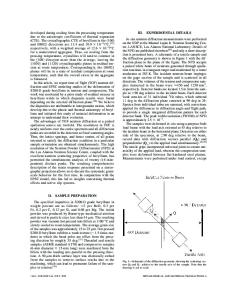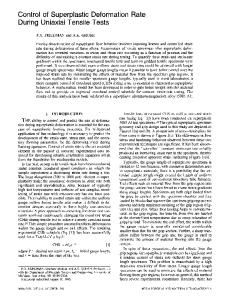Uniaxial tensile deformation of uranium 6 wt pct niobium: A neutron diffraction study of deformation twinning
- PDF / 345,752 Bytes
- 10 Pages / 612 x 792 pts (letter) Page_size
- 18 Downloads / 344 Views
INTRODUCTION THE crystal structure of solid pure uranium at high temperatures (776 ⬚C ⬎ T ⬎ 1132 ⬚C) is body-centered cubic (␥ phase).[1] On cooling, uranium experiences a solid-solid phase transformation to the tetragonal  phase followed by a second transformation to an orthorhombic ␣ phase, which is stable at room temperature. To stabilize the ␥ phase at room temperature, attempts have been made to alloy uranium with other elemental metals such as Mo,[2,3] Nb,[4] Zr,[5] and Ti,[6,7] each of which is soluble in the high-temperature ␥ phase. Although these elements have minimal solubility in the  or ␣ phases of uranium, metastable alloys can be formed through rapid quenching from the high-temperature ␥ phase. The addition of niobium to uranium is of particular interest because it significantly increases the oxidation resistance. Also, in U-Nb alloys, the Young’s modulus is reduced and the ductility is enhanced relative to pure uranium.[8] Depending on the Nb concentration, U-Nb alloys exhibit the following room-temperature structures on quenching from the ␥ phase: ␣⬘ orthorhombic (0 to 10 at. pct, 0 to 4.2 wt pct); ␣ ⬙ monoclinic (10 to 16 at. pct, 4.2 to 6.9 wt pct); ␥0 tetragonal (16 to 20 at. pct, 6.9 to 8.9 wt pct.[4,9–12] using the notation suggested by Lehmann and Hills.[13] Vandermeer et al. report a dual phase, ␣ ⬙ and ␥0, near the boundary of the monoclinic and tetragonal structures at a Nb concentration of 6.54 wt pct.[14] The ␣⬘ structure is similar to pure ␣-uranium but with altered lattice parameters, while the ␣ ⬙ and ␥0 structures are distortions of ␣-U and ␥-U, respectively. The monoclinic structure of the ␣ ⬙ phase is characterized by a ⬃2 to 3 deg increase of the ␥ angle of orthorhombic pure uranium. In this paper, we focus on an alloy with a Nb concentration of 5.77 wt pct (U6Nb). Dilatometer experiments suggest that on quenching from the ␥ phase, U6Nb first transforms into the ␥0 tetragonal phase before undergoing a martensitic phase transformation to the room-temperature ␣ ⬙ phase.[9] D.W. BROWN, M.A.M. BOURKE, and M.G. STOUT, Technical Staff Members, MST-8, and P.S. DUNN, R.D. FIELD, and D.J. THOMA, Technical Staff Members, MST-6, are with the Material Science and Technology Division, Los Alamos National Laboratory, Los Alamos, NM 87545. Manuscript submitted May 5, 2000. METALLURGICAL AND MATERIALS TRANSACTIONS A
The uranium-rich U-Nb alloys in the ␣ ⬙ and ␥0 phases exhibit the shape memory effect (SME), where SME, in this case, refers to the ability to recover deformation-induced permanent strains by subsequent heating. Jackson et al. first reported SME in a U-Nb alloy in 1978.[15] A systematic phenomenological study of the SME as a function of Nb concentration between 6.0 and 7.8 wt pct demonstrated the SME in both the ␣ ⬙ and ␥0 phases, although larger strain recovery was observed in the ␣ ⬙ phase.[14] In the case of UNb alloys in the ␣ ⬙ phase, strain recovery of up to ⬃ 0.07 is realized by unloading ( ⫽ 0.025) and heating to ⬃1100 K ( ⫽ 0.045).[14] Consistent with other materials th
Data Loading...











